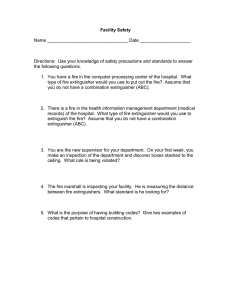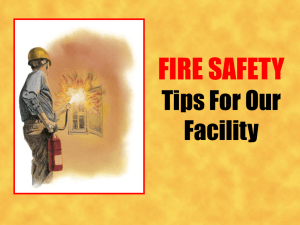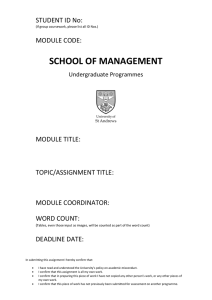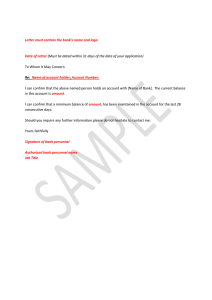SFS-10
advertisement
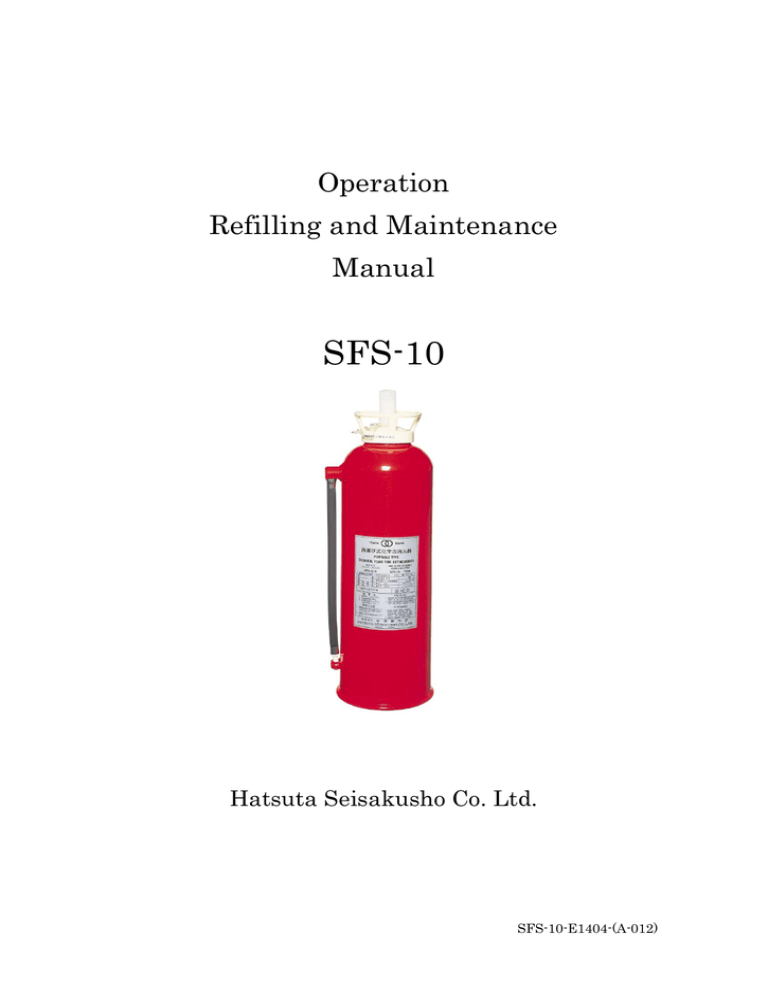
Operation Refilling and Maintenance Manual SFS-10 Hatsuta Seisakusho Co. Ltd. SFS-10-E1404-(A-012) 1. Fire Classification Normal Combustibles (A Class) and Oil and Flammable Liquid Fires (B Class) 2. Fire Extinguishing Mechanism The extinguishing agent is comprised of agent A (outer container agent and agent B (inner container agent) Agent A is based on Sodium Bicarbonate (NaHCO3), it includes a foam forming and stabilizing agent and comes in a powder condition. In solution it is an alkali. Agent B is based on Aluminum Sulfate (Al2(SO4)3) and is a white powder. In solution it is an acid. When the extinguisher is turned over, agent A and agent B mix and a chemical reaction occurs that creates carbon dioxide gas. This gas pressurizes the extinguisher and chemical foam is produced with an expansion ratio of between 7 and 8. The resulting foam has a neutral pH (between pH 6.8 and pH 8.7) When the foam is discharged on to the fire, it forms a blanket that shuts out the air to the fuel and also cools the fire to extinguish it. SFS-10-E1404-(A-012) 3. How to Use 1. Remove the hose from the holder and hold your finger over the nozzle end. 2. Remove the safety cap and push the puncture knob 3. Turn the extinguisher upside down, hold the lower part and shake the extinguisher up and down 2 to 3 times. 4. Aim the nozzle at the base of the fire, remove your finger from the nozzle, and sweep the nozzle aiming at the base of the fire. Caution: In the above operation, the puncture knob breaks the lead seal on the inner container and agents A and B mix to create carbon dioxide. The carbon dioxide provides the pressure to discharge the foam through a strainer, the hose and the nozzle. With this type of extinguisher the discharge cannot be stopped after it has started. If you want to stop discharging foam after it has started, turning the extinguisher back to the original orientation will cause the gas to discharge and the foam discharge will stop. 4. After Use 1. Check there is no pressure left in the extinguisher and put the extinguisher in a clamp 2. Remove the cap using the cap remover and take out the inner cylinder 3. Remove the cap from the inner cylinder and remove the used lead plate. 4. Thoroughly wash the inside and outside of the internal and external cylinders, the inside of the hose and strainer and cap. (Especially wash the functioning parts). Note: It is difficult to remove the foam after it has dried. SFS-10-E1404-(A-012) 5. Refilling the Extinguisher * We recommend that you replace the extinguishing agent once a year SFS-10-E1404-(A-012) 6. Maintenance 1. The fire extinguisher should be installed in accordance with the appropriate regulations for marine use. 2. It should be installed where it can be easily accessed and used and measures should be taken to prevent it from falling over 3. The extinguisher should be installed so that the top of the extinguisher is less than 1.5m from the floor 4. Install the extinguisher in a place where the operating temperature range will not be exceeded as the extinguishing agent may degrade. (Avoid direct sunlight, heaters, and high humidity areas.) 5. The extinguisher should be inspected at least once every 6 months by fully trained personnel, (preferably once every 3 months) 6. Maintenance should be carried out in accordance with S50,11,13 section 168. 7. Any altered parts, in particular seals, are an indication that the extinguisher has been discharged. 8. The extinguisher is a pressure vessel. Caution is required for rust, deformation and damage. 9. After use, leaving the extinguisher without maintenance will cause the remaining foam to solidify and there is a danger of parts corroding. After a discharge carry out maintenance soon, or re-fill the extinguisher. SFS-10-E1404-(A-012) External Inspection Installed Condition 1. Place of Installation Confirm the extinguishers are installed at a place with easy access and do not interfere with the evacuation route, and the extinguishing agent is reasonably safe against freezing or deterioration. 2. Applicability Confirm the extinguishers are of a type applicable to the hazard. 3. Earthquake Resistant Measures Confirm the appropriate counter measures are taken to prevent overturn of extinguishers that may leak if turned over. Description and Identification Confirm the description and identification of the fire extinguishers are free from damage, stains, are not falling off or unreadable, and that specific description and identification such as name plate are provided. Fire Extinguisher 1. Cylinder Confirm the cylinder is free from leaks, deformation, damage, and corrosion. 2. Safety Device Confirm the safety device is free from deformation, damage or the like, and that it is properly provided. 3. Operating Device, such as Push Fittings and Levers Confirm that the operating device is properly set. 4. Seal Confirm that the seal is free from damage and it properly applied. 5. Cap Confirm the cap is free from damage or deformation and it is properly attached 6. Confirm the hose is free from damage, deformation, bloking or the like, and that it is securely connected to the body. 7. Nozzle Confirm the nozzle is free from damage, deformation, blocking or the like. 8. Safety Valve – Pressure – Reducing- Plug Confirm the safety valve is free from damage, deformation or the like and it is securely fitted. 9. Holder Confirm the holder is free from damage, deformation, notable corrosion or the like, and that it permits easy removal of the fire extinguisher. SFS-10-E1404-(A-012) Inspection of Performance Cylinder Body, Internal Cylinder, Etc. 1. Cylinder Confirm the inside surface is free from corrosion, the rust proof coating is not flaking off or the like. 2. Internal Cylinder Confirm the internal cylinder is free from damage, corrosion or the like. 3. Indication of liquid level Confirm the liquid level is properly indicated. Fire Extinguishing Agent 1. Properties Confirm the extinguishing agent is free from discoloration, decomposition, precipitate, soil or the like. 2. Quantity of Extinguishing Agent Confirm the quantity of agent is correct. Cutter and Puncture Knob Confirm the cutter and puncture knob are free from damage, deformation, or the like and operate properly. Hose Confirm the hose and hose connection are free from blocking or the like. Safety Valve and Pressure-Reducing Plug Confirm the safety valve and reducing plug are free from damage, deformation, blocking or the like and operate properly. Seal Plate and Packing 1. Stopper for Outlet Tube Confirm the plate is free from damage, deformation or the like and is fitted properly. 2. Packing Confirm the packing is fre from damage, deformation or the like. Outlet Tube and Gas Siphon Confirm the outlet tube and gas siphon are free from damage, deformation or the like and is fitted properly. Strainer Confirm the strainer is free from damage, deformation or the like. Air Vent Valve Confirm the sair vent valve is free from damage, deformation, blocking or the like and operates properly. SFS-10-E1404-(A-012)
